Steve Zocek
Prior to Everton reaching the FA Youth Cup Final in the season of 1976/77 the young Blues had made their bow in the final of 1960/61, where they were beaten 5-3 on aggregate over two legs by Chelsea. Four year later, the youth side again reached the peak of the competition, going one better than their previous encounter. Extra time prevailed in second leg at Goodison as the Blues edged their way to victory, with an aggregate score of 3-2 over Arsenal. In the season of 1976/77, Colin Harvey’s youngsters reached the final of the FA Youth Cup, facing London opposition for the third time in their history, with Crystal Palace being the opposition. This is the story of that campaign, and features many of the players from both camps who featured in the run up and played in that tense final.

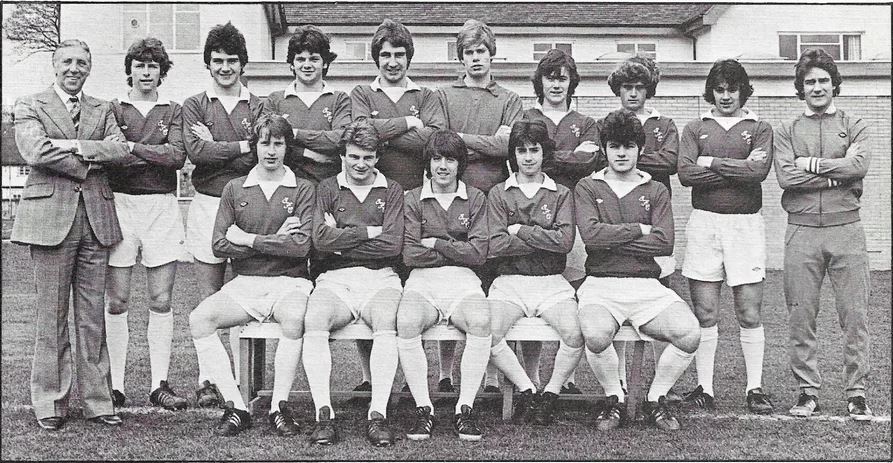

On Monday 6 December 1976, Everton were drawn away at nearby Tranmere Rovers in round two of the FA Youth Cup. Everton suffocated Rovers, winning 6-1. Brian Monaghan opened the scoring as early as the third minute and added a second on twenty-seven minutes, giving the Blues a two-goal cushion at the interval. Joe McBride added a third on fifty-two minutes with a header. Joe revealed that this was his first goal at any level for the club. Monaghan completed his hat-trick on seveny-one minutes and, five minutes later, Martin Murray got himself on the scoresheet with Everton’s fifth. The scoring didn’t stop there, with Ross Jack stretching the lead to a margin of six. The hosts lost two players, Colin Lewis and John Kerr, through injury, leaving them with ten players to finish the tie. Rovers’ Milne headed a late consolation but the result was a foregone conclusion by then.
Speaking with Billy Russell he said, ‘It was a close contest in the early stages but we took our chances, which to be fair, didn’t put a true reflection on the game.’

In the following round, Everton benefited from home advantage against Nottingham Forest. Brian Monaghan, the hat-trick hero from the previous round, carried on where he left off, finding the net on thirteen minutes. The visitors drew level when Everton’s Jimmy Milne slipped as he attempted to clear the danger from a Forest attack, only to put the ball beyond his own ‘keeper, Nick Banner. In the replay at the City Ground, Nottingham were looking likely to score, until Billy Russell’s free kick found Monaghan to head Everton into the lead with thirteen minutes left to play. Ross Jack eased his sides nerves by adding a third, when he intercepted a pass from the right-hand side. Forest fought hard with great determination to get themselves back into the tie, and there was a last minute scare when they were awarded a penalty. Banner, Everton’s keeper, dived full length to keep the ball out, before heroically saving another shot from the rebound to ease his side’s passage into round four. That was the first of two penalties that he saved on the road to the final.
Everton were drawn away to Oldham Athletic and got off the mark when Brian Monaghan lobbed the Latics’ goalkeeper to set Everton on their way. Mark Higgins netted his first of the competition, with Martin Murray scoring to send them 3-0 up at half time.
Oldham’s Jordan pulled one back on fifty-two minutes, then with ten minutes remaining, the home side was awarded a free kick, with Taylor making no mistake, reducing the deficit to one goal, and setting up a very nervous ending. Two goals were scored in the last two minutes. Joe McBride added Everton’s fourth of the night, with Jordan scoring his second, making the score 3-4. When speaking with Joe later he had no recollection of the goal that night. The Liverpool Echo’s headline was “BLUES MADE TO FIGHT”.

The reward for their away joy was home advantage in the next round and a visit from the north-east side Middlesborough. A double from Ross Jack, and Martin Murray with his third of the tournament, gave Everton an easy passage into a semi-final tie against Derby County, with the Baseball Ground hosting the first of two legs. Tottenham Hotspur and Crystal Palace were the other two semi-finalists.

Joe McBride was very familiar with this game because the coach at Middlesborough was Bobby Murdoch, the first-team coach at Ayresome Park, who had played with Joe’s father at Celtic. ‘Every time I met Bobby Murdoch, ten, twenty years later, he always talked about that FA Youth Cup game. He remembered it really well,’ Joe enthused.
The first leg was held on Monday 4 April 1977. The home side, as expected, pressed, but the visitors held out for the first forty-five minutes with the only downside seeing Ray Deakin miserably stretched off with a knee injury. It remained goalless at the interval.
The Rams almost drew first blood two minutes into the second period, as Nick Banner made a gallant save from Liverpool-born defender Rob Corish.
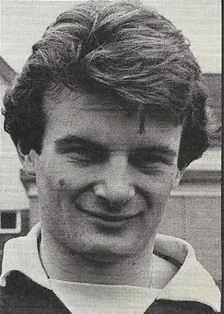
Mike Coffey opened his account in the tournament for the Blues on seventy minutes, delicately chipping the defender and ‘keeper to give Everton the lead. It was the visitors who stretched their lead four minutes later when goalscorer Coffey sent over a cross, which was blocked by Steve Cherry, with the ball falling kindly into the path of Joe McBride who nudged the ball over the line. Joe laughed when I described his goal from the report: ‘I smashed it in from half of a yard!’ he proclaimed.

Goodison staged the second leg five days later. The home side looked to be the favourites with a two-goal advantage. As expected, Everton’s youngsters pressed, causing problems for the opposition with Mike Coffey firing wide; then an effort from Joe McBride saw his shot tipped over with Steve Cherry in the Derby goal alert.
It was the visitors turn to show a threat as Nick Banner kept a shot out to keep the game scoreless. The 2,500 plus crowd gasped as the visitors reduced the deficit. Centre-back Jimmy Milne’s back pass to his keeper lacked pace and the ball was intercepted by the opponent to net the opener.

Trailing by one goal at half time, Billy Russell headed home an equaliser in the second period, which he describes as very rare, to send Everton through to the final of the FA Youth Cup with an aggregate win, for the first time since 1965.
‘Everton will go for goals at Goodison Park tonight in the first leg of the FA Youth Cup Final against Crystal Palace and Martin Murray will be out to add to his total this season,’ wrote Alex Goodman of the Liverpool Echo.
‘Murray, hailed as a future top-class player when he signed from the League of Ireland club Home Farm a couple of seasons ago, has scored four goals in Everton’s march to the final. And tonight, he will again be in his normal midfield position, playing alongside Paul Lamont and Mike Coffey in a 4-3-3 formation against Crystal Palace who have scored 24 goals in their Youth Cup matches.’

‘Everton’s front three, Ross Jack, Brian Monaghan and Joe McBride have all scored as well in other rounds and youth officer Ray Minshull said; “We want as big a lead as possible to take to Palace, but I’ll be happy if we are just one goal in front at the end of the two matches.” The team will be picked from a 13-man strong squad but is expected to be at full strength with Mark Higgins, the only youngster with first team experience, taking his normal position in defence.’
The game kicks off at 19.30 and Mr. Minshull said, “We are hoping to get as bigger crowd as possible to support the lads. We don’t even mind Liverpool supporters coming along.” The second leg of the final is at Selhurst Park on May 13th. The squad for the first leg is:
Banner, Russell, Milne, Higgins, Deakin, Heard, Murray, Lamont, Coffey, Jack, Monaghan, McBride, Stenson

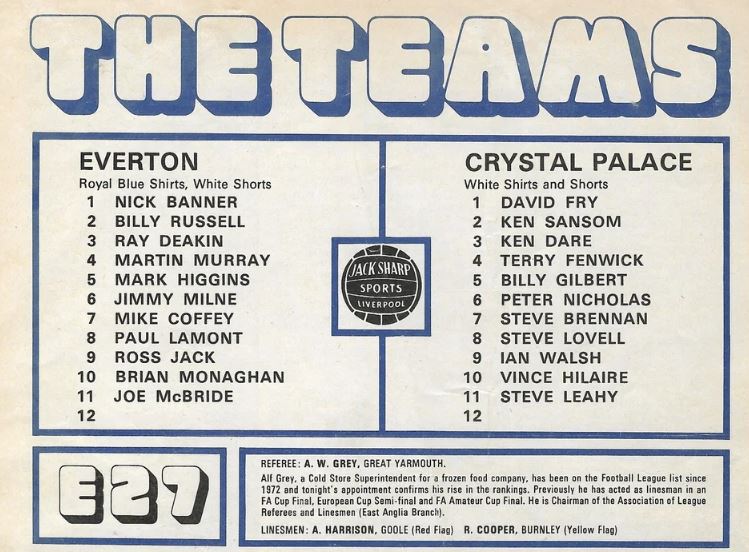

EVERTON 0 CRYSTAL PALACE 0 FA Youth Cup Final, First Leg
Everton’s youngsters failed to capitalise on their home advantage in front of nearly four and a half thousand fans, being held to a goalless draw as the Eagles’ youngsters gave a very spirited performance going into the second leg a week later. The visitors had two of the game’s best chances as Everton’s keeper Banner denied Ian Walsh and Vince Hilaire opportunities. Banner turned away Hilaire’s shot, which was destined for the top corner.
Billy Russell said of the first leg: ‘We played well creating a few chances, but we kept them at bay for most of the time. If we would have won one or two nil, it would have been a fair result. Down there for the return game, we again produced some scares until they scored late on which felt like a body blow.’
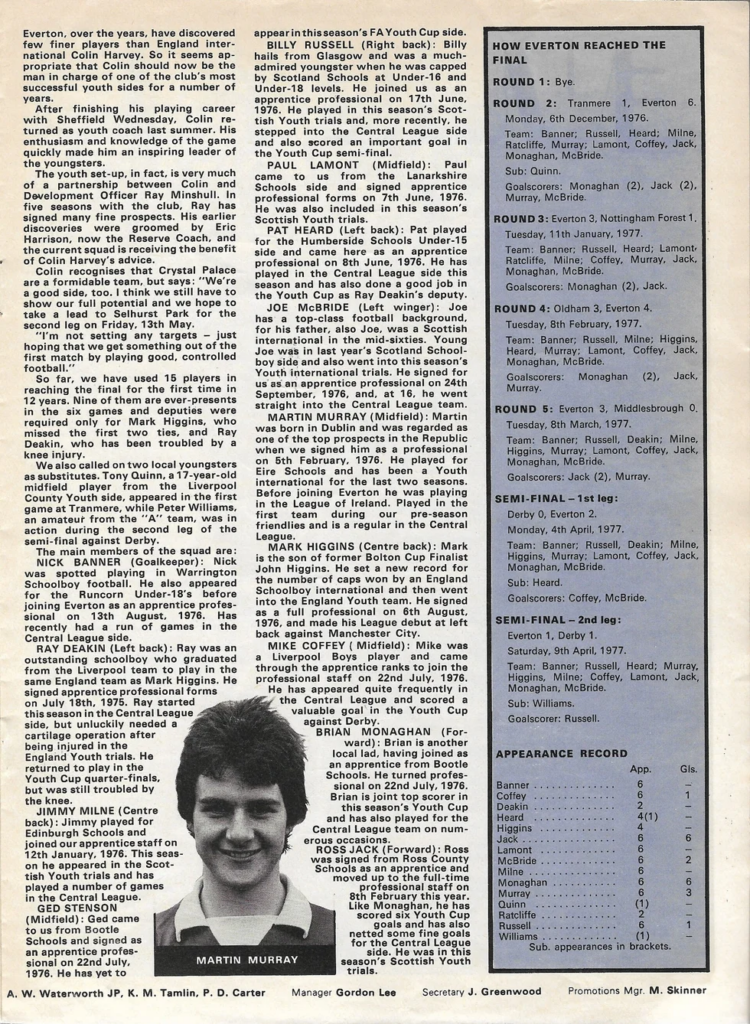
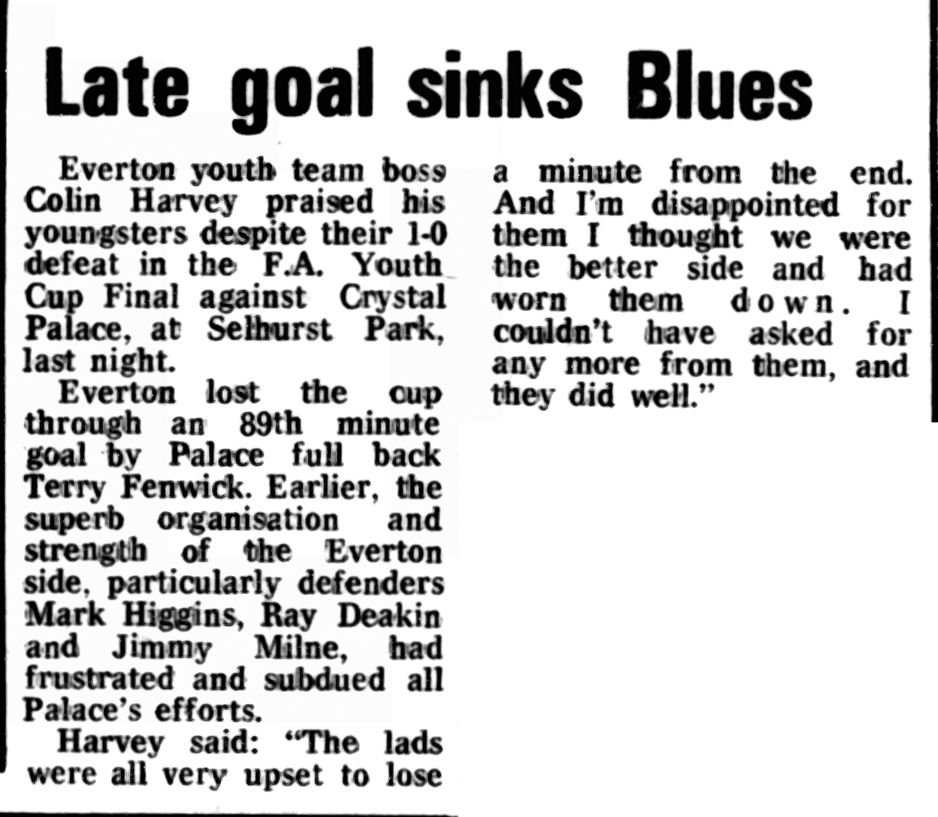
CRYSTAL PALACE 1 EVERTON 0 FA Youth Cup Final, Second Leg
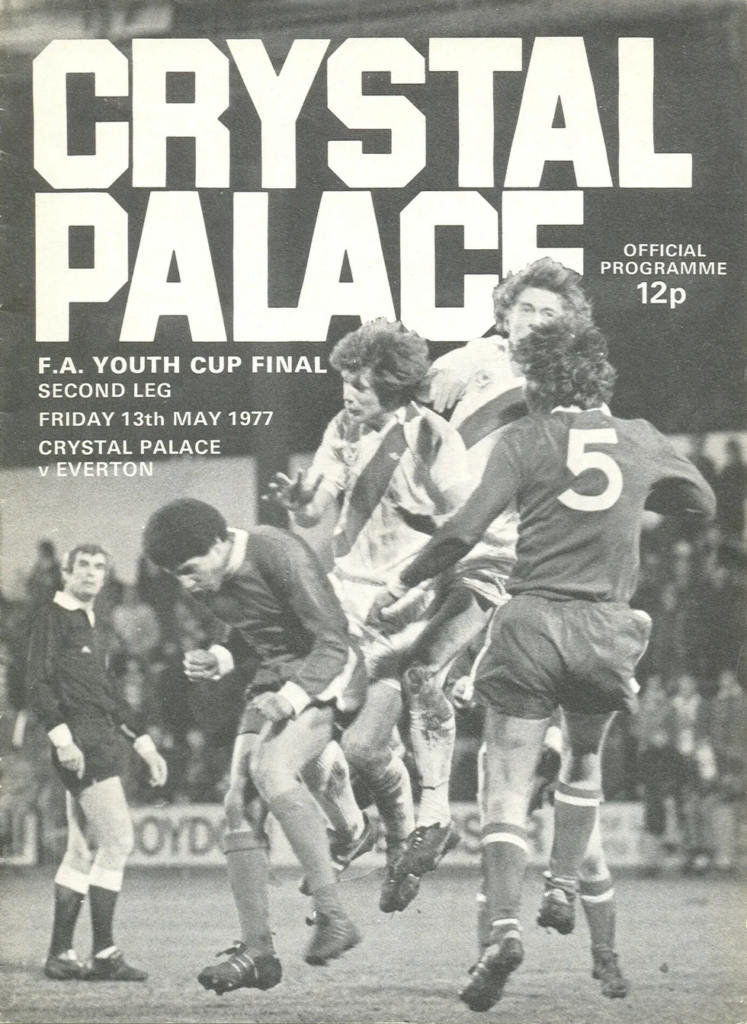
Joe McBride said of the Crystal Palace side: ‘They had five or six lads in that youth team that had also played in the first team, so were experienced. Kenny Sansom, Vince Hilaire, Terry Fenwick, Peter Nicholas, Jerry Murphy and Ian Walsh. I also remember that afternoon waiting with excitement for the game to come around. It felt like one of the longest days of my life.’
‘In the game itself, I was up against Kenny Sansom,’ added Joe. ‘I don’t remember much about the game only the fact it was a very tight contest. Terry Fenwick scored the winner virtually with the last kick of the match.’
As you can imagine, we were devastated. Gordon Lee, the first-team manager at the time, attended the game at Selhurst Park. ‘He came into the dressing room after the game to congratulate us all. He reminded us that it was great achievement to reach the final. He told us to always remember the feeling of losing the final and hopefully you will get the chance to put it right one day. That was a nice touch from him. I have fond memories of the whole run to the final.’
Joe these days is still involved in football and told me that he was on a coaching course with Peter Nicholas, who was on the opposite side for Crystal Palace, and that they still talk about that night whenever they meet up. Joe is involved in the SFA performance school in Glasgow, and is also an assistant coach to the U17 national team.
Billy Russell said, ‘In the hotel after the game, everybody was feeling devastated, and we all congregated in someone’s room. Then there was a figure who entered room and it was Colin Harvey. He tried to console us and then announced to three of the lads that they would be playing for the reserves at Goodison the following night!’
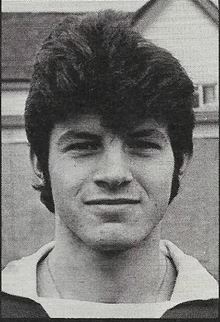
‘One of the three was me, so we got on a train early next morning to prepare for the game at Goodison. There were five Scottish boys amongst us in my first year as an apprentice. Jimmy Milne, Joe McBride, Ross Jack, Paul Lamont and myself. In training, Colin Harvey used to make things quite competitive back then by having the Scots playing England. Colin was a good coach who passed a lot of useful information on to us. He would participate in sessions still not having lost the touch from his playing days. He had this tenacity to win.’
Nick Banner described the two-legged affair as very even. The goal that won the game at Selhurst Park was scored by Terry Fenwick, who could not have got any closer striking a ball with accuracy which found the back of the net.
‘The atmosphere at Selhurst Park was amazing. There were 14,045 fans in attendance.’ Nick commented that because the crowd was very close to the pitch there was a lot of noise, something he had never experienced before. ‘There was the odd object being thrown onto the pitch with the intention of putting you off.’
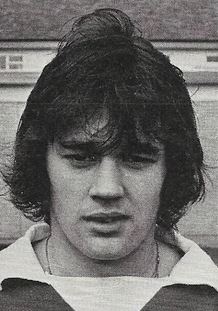
Joe McBride remarked on the away leg and the attendance: ‘14,000 plus to us was massive as kids. The game was very tight. I recall our own Jimmy Milne going into a tackle with Vince Hilaire, which if it was repeated today, it would result in a jail sentence!’
Nick Banner left Everton for Runcorn, who played at Canal Street, where he stayed for a season before joining Bangor City. Whilst at Farrar Road, Stoke City were monitoring his progress. He agreed to terms to join the Potteries club to compete with the green jersey with Peter Fox. However, when manager Alan Durban left Stoke to join Sunderland, the deal fell through.
Nick then had the misfortune of breaking a wrist, and, after sustaining other injuries, he decided to turn his back on the game, having lost the confidence to play. He then turned to property estate agency and successfully made it on to the board of directors of a firm.
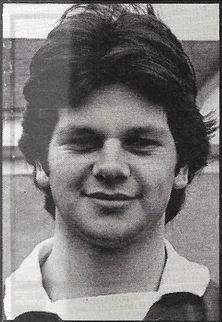
Ross Jack joined Everton from Ross County at the age of sixteen as an apprentice, after being monitored by the Merseysiders from the age of fourteen. He would spend his school holidays and weekends at Bellefield. Ross played as a centre forward until he joined Norwich City, converting to an attacking midfielder. He made a career in football and to this day is still involved with the academy at Inverness Caledonian Thistle. He held a managerial post in the Scottish Highland league with Rothes FC. In April 2023, Jack was inducted into the Dunfermline Athletic Hall of Fame.
Ross’s memories of that FA Cup Final run in 1977 needed a few prompts, but he stated, ‘We were favourites to beat Tranmere at Prenton Park, which the Toffeemen won comfortably 6-1. It proved to be tough early on, and I do remember scoring one of three goals.’
In the following round against Nottingham Forest at home, the Blues progressed winning 3-1. Ross’s recollection of that encounter was that it was a very tough game, much harder than the scoreline suggested. He was convinced that he scored two in that one, not Brian Monaghan. I wasn’t prepared to settle the dispute. Irrespective, his goal was a header. Ross described the fourth-round tie at Oldham as a really difficult encounter: ‘It was a very tough game. They had a couple of boys that had played in the first team. It was a good win and was nice to progress.’ Into the hat for the quarter final at home to Middlesborough, Ross netted twice. He replied: ‘We were superb that night in front of a good crowd. I remember a lot of the first-team boys came to watch us and we played very well.’
Regarding the semi-final at Derby County Ross confessed, ‘I don’t know much about that one other than it was a big ground, and in the second leg, I don’t recall anything at all. Did I score in that one?’ he asked with anticipation. ‘Ah, so it was Billy Russell? He used to play right back for us and scored very few goals, but he would have been delighted with that one.’
Goodison held its first FA Youth Cup Final in twelve years against Crystal Palace. ‘It was a terrible result, not a very good performance at all,’ said Ross. ‘Like Oldham in the earlier round, they had six boys that had already played in their first team. We had a lot of the first-team boys watching again, and I think we let ourselves down a little bit. I think the nerves got the better of us to be honest. I do remember Mark Higgins having an outstanding game at centre half.’
Recalling the second leg Ross explained, ‘I can remember the huge cry of “Eagles, Eagles” echoing around Selhurst. It was probably the biggest crowd that we’d played in front of as kids. I don’t think we played brilliantly, but felt hard done by. We didn’t do enough to win, but it was gut-wrenching to lose to an 89th minute winner.’
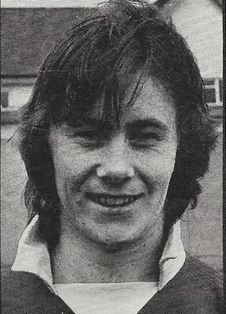
Brian Monaghan, who joined Everton from Bootle Schools, signed professional forms with Everton in July 1976 under the management of Billy Bingham. Brian was prolific in front of goal, sharing the honour as top goalscorers of the FA Youth Cup run in 1976/77 with Ross Jack, both scoring six.
Brian thought back to the opener against Tranmere Rovers, ‘I remember it was a rain-soaked pitched with plenty of mud. We won that game 6-1. I can’t remember the details but I recall getting a couple.’ In fact it was a hat-trick, which brought a huge smile to his face.
Thinking he would struggle to recall each round, regarding the Forest game he immediately responded, ‘I scored a header in that one. I met a cross from Billy Russell.’ That was one of two he scored that day. He could remember nothing of Oldham, while of Middlesborough he could only remember the score, correctly suggesting ‘Was it 2-0?’
On to the final against Crystal Palace, ‘The first leg, I recall that we didn’t have too many chances, unfortunately drawing a blank. We had some great players in our team. Mark ‘Higgy’ Higgins was the captain of the England youth side, Martin Murray was the captain of the Republic of Ireland side, John Brogan, who captained Scotland youth. Colin (Harvey) made me captain of the Everton youth team when he took over the reins from Eric (Harrison).’
‘In the away leg, I can recall a massive melee in the middle of the field when Jimmy Milne did Vince Hilaire. Before Palace got the winner, I was on the right wing, going on the inside, pinging a ball across with my left foot to Ross (Jack) on the edge of the six-yard box, who NEVER missed anything in the air, nodding it wide past the post. We couldn’t believe it. They, of course, got the winner. Then it was tears for souvenirs in the changing room after.’
Brian reflected how close he was to being a first-team regular in his time at Goodison Park before leaving. He told me, ‘I was a bit of a blue-eyed boy to manager Billy Bingham. Mick Lyons had written an article for the Liverpool Echo, referring to me as the next Duncan McKenzie about to break into the first team. I accompanied the first team on a few away trips as the 13th/14th man in the good old days. Newcastle United and Leeds were two of the trips I went on getting a taste for it.’
‘I was a regular for the reserves, so was invited to train with the first-team squad, as was Barry Wellings, who was also showing promise. Ross Jack was another that was in the same kind of position. Billy Bingham, who was also manager of Northern Ireland, was dismissed in early January 1977 and replaced by Gordon Lee. I was still playing well, scoring goals regularly, nothing had changed. Out of the blue, Gordon called me in to his office telling me that he didn’t want me. He told me that he thought I had the ability to score goals, but that I wasn’t his kind of player. It was devastating for me as I bled blue. By that time, Billy Bingham had gone to Mansfield Town as manager. If any consolation, there was interest in me from Ron Atkinson, who was managing Cambridge United.’
Today, Brian is now in his early sixties and proud of what he’s accomplished. He continued the story following his release from Everton, ‘Around the time of 1977/78, a few of the boys who had been with me, Mike O’Halloran, Dave Kelly, and Billy Brindle at that time, the NASL, (North American league) was going downhill. The Australian pro league was taking off. The lads who I have just mentioned were playing over in Australia. There was a guy out there called John Benison, who later became chief scout at Liverpool, contacted me to tell me that there was a club in Australia, a Czechoslovakian-based side called Paran Slavia. Eamonn Bannon (ex-Dundee United) was there, even Martin Peters came out for one season. So, in Australia, I was there for two years. I got asked to become an Australian citizen, and the opportunity to play for the national team.’
‘Billy Bingham brought me back home to Mansfield Town for three months while they were trying to get my release. The Australian Federation refused to release me as I was under contract. I roomed with another ex-Everton guy, Nigel Groome, who I knew well, praying that my contract in Australia would be terminated. There was no way I was going to be let go, so I returned to Australia for a further season.’
‘When my time was up there, I returned to Liverpool (Bootle), and from the age of 23-26 I played for Burscough, Pwllheli and my local team Bootle as a semi- pro. Then, all of a sudden, a Portuguese guy called Francisco Marcos (who started the US Pro Soccer League in 1986, and was later involved in the 1994 World Cup) contacted me telling me of his plans to get the indoor soccer league started. I came over to meet him in the Christmas of 1986, I took a six-month contract as didn’t want to commit. I was playing with two greats; Marcos also brought in Wolfgang Suhnholz of Bayern Munich and Antonio Simoes da Costa, who was probably second behind Eusebio as a Portuguese star until Ronaldo appeared.’
‘Another name I forgot to mention that was also involved in the organisation was Emmanuel Sanon, who scored for Haiti in the 1974 World Cup in West Germany against Italy. Wolfgang Suhnholz paid me a huge compliment one day comparing me to Gerd Muller. He told me that I always wanted to score goals, but meant it in a way that I cared for nothing else but to score goals. I was always miserable if I came off the pitch without scoring and would be ready for the next game. Those two guys actually encouraged me to get into coaching.’
‘Another person that had another impact on me regarding my coaching was a German by the name of Horst Bertl, who was Kevin Keegan’s room-mate from their playing days at Hamburg. He was over in north Texas and heard about me through Wolfgang (Suhnolz), and at that time, Horst Bertl was in charge of all the football in America; the National, the regional teams, recommending players who he believed would be sent over to Europe. Around 1989/90, he requested me to come in and get involved in the coaching direction.’
‘I now run a club as an executive director at a club called Lonestar SC in Austin, Texas with nine thousand players. The ages range from 5-19. There are boys and girls who go on to play for the national teams and also go to college.’
Martin Murray
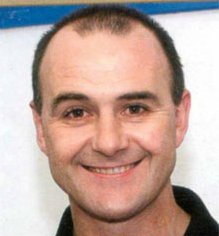
I caught up with another member of that team, a young Irishman named Martin Murray, whose three goals led to the path to the final. Unlike his team-mates, he was very unsure about details, but said that if he were amongst some of the lads today, he was convinced memories would slowly return. He remembered Tranmere as the first game, and scoring but little more. The following rounds were just as vague, but happy his goal tally went up to three. ‘I know we played Derby County in the first leg of the semi-final at the Baseball Ground.’ The second leg again was a blur, but when I mentioned the final, ‘Crystal Palace!’ came the cry. Do you recall anything of the first leg I asked? ‘Absolutely not!’ he replied.
Martin was much clearer about the second leg at Selhurst Park when he started to chuckle: ‘I remember a huge outbreak on the field with many players from both sides scuffling. I threw a hand out at Peter Nicholas, which caught his head resulting in me breaking a bone in my hand. I remember afterwards in the medical room and Terry Venables entering. That’s about all I remember.’
Martin could not leave without mentioning coach Colin Harvey: ‘Colin played the game and was a great motivator, not cut from the same cloth as Eric Harrison, which is said with the greatest respect.’
Martin these days works away a great deal. At the time of our conversation, he had been working in Milan for around 16 months. His intention is to stay until he decides to retire. Martin spends his time working in an office for a company that started as an electrical contractor in Ireland, which continued to grow. They have bases all around Europe.
Mark Higgins (Captain)

Mark was an England schoolboy prior to joining Everton. He had the leadership skills at a very young age when he captained his country and in later years Everton. He holds the record for the most capped schoolboy at that level, and was proud to have played at the old Wembley Stadium before the age of Fifteen. Incredible!
In the run to the final of the FA Youth Cup, Mark featured in four of the six games up until the final. He was absent from the game at Tranmere Rovers in the opener and missed the game in the following round at home to Nottingham Forest. He then featured in every game.
‘It’s so hard to recall detail from games when they were so long ago,’ Mark says. From round five, his recollection improved, although Derby County came as a surprise when I reminded him that they stood in their way of the final. ‘I can remember the first leg of the final with Crystal Palace as we were at home and we drew 0-0. I can also recall the second leg at Selhurst Park which was also a night fixture. I can remember coming up against Vince Hilaire and Kenny Samson, who, like myself, went onto play in the first team. I know that Palace side were very good. I remember the feeling of being gutted after we conceded a last-minute goal which proved to be the winner. We were unfortunate to lose as we didn’t deserve to. At any level of any sport, when you reach the final, you want to win. Everton in ‘84 had the fortune to win the FA Cup, but saw themselves on the losing side in ’85 and ’86 respectively. We were young kids and wanted to win.’
‘After experiencing defeat in that final, one thing I must mention that would never happen today, is that the reserve-team manager Eric Harrison told me to report the following day at Goodison to play for the reserves against Leeds United in a 3pm kick off.’
Pat Heard

Humberside-born Pat Heard played for his county boys U15 team before signing for Everton as an apprentice pro in June 1976. He made four appearances in the FA Youth Cup run, including one as a substitute. Like many, Pat found remembering detail from years ago difficult, but I did manage to get some facts from him.
‘I can’t honestly remember. I do recall buying a grey pin striped suit from a menswear shop called Jonathan Silver for the final. I paid around £7 for it. The shop assistant asked me if a tie was required to go with the suit to which I replied yes. I bought a tie and unknown to me until one of our lads told me, it was in the colour of our opponents Crystal Palace!’
‘Of the game itself, all I can remember was the crowd chanting “Eagles” repeatedly. That for me was quite intimidating. I don’t think at that time I knew the size of the game. I don’t think we took in the magnitude of the game. I seem to remember that when we lost, I wasn’t that upset.‘But the big thing was that their squad had more experienced players. As I remember, six of those already had first-team experience whereas we weren’t fortunate enough to have that strength. At that time, it was the biggest crowd I had ever played in front of, which was fantastic when you’re a young lad.’
On the run-in he said, ‘I didn’t realise I played that many games in that run because all the lads in that group were all a year above me. I knew I was involved in the semi-final against Derby County, but unaware of any part of the earlier rounds. I would never have played in those games if the late Ray Deakin would have been fit. Ray was an England youth international, but suffered with a very bad knee injury, enabling me to step in.’
Deakin was an unfortunate victim of injuries when Heard first joined Everton. Heard explained: ‘He did make the odd comeback game, but always seemed to have a relapse. He could play two games then break down again. As a young lad, he was of a similar build to Higgy, but his injury, looking back, was a cruciate ligament damage which was unknown to us back then as nobody knew the terminology for it. In those days, the worst injury you could get was either a broken leg or a cartilage injury.’


Crystal Palace
Malcolm Allison was appointed manager at Selhurst Park in March 1973 and arranged a meeting with his chairman requesting £280,000 (£4.6m in today’s money ) with the intention of recruiting the best sixteen youngsters in the country. The team he assembled became known in some quarters as ‘The team of the eighties.’ Of the sixteen players brought in, eleven of them went on to play in the first team, nine of which also went on to become internationals. Over a two-year period, Terry Fenwick and his brother David arrived from Seaham, a seaside town in County Durham. Goalkeeper David Fry signed from Weymouth. Allison also introduced three Welsh boys, Peter Nicholas, Ian Walsh and Steve Lovell. There was also Vince Hilaire, Kenny Sansom, Jerry Murphy and Steven Leahy, who were all London lads.
These young Eagles played in what was called the South East Counties League, which was made up of London teams. Allan Harris (brother of the ex-Cheslea player Ron) and John Cartwright, who had worked for Palace between 1971-78, won the FA Youth Cup in both 1976/77 and again 12 months later. Malcolm Allison had the youngsters coached on the Dutch way of football. Jerry Murphy, Vince Hilaire, Kenny Sansom, Ian Walsh, Peter Nicholas, Billy Gilbert and Terry Fenwick were first-team regulars whilst turning out for the youth team, which explains their success at that level.
Captain Peter Nicholas appeared in every single game of that triumphant competition. Peter shares the same amount of Welsh caps with Ian Rush standing 13th in the appearance table. He explained, ‘The games were such a long time ago; we’re talking 46 years. I do remember that both games were very tight and the sides were evenly matched, but I think we probably deserved to win it. Both teams had the same desire to go out to win. Fortunately, we were the team that came out on top. Joe McBride and myself struck up a good friendship from that game and still remain friends to this day.’
Vince Hilaire scored six goals in the competition, having appeared in every game: ‘Both of the games were very tight contests with Everton at that time a good young side. I was familiar with a few of their team members, Joe McBride, who we were told to watch carefully, and also Mark Higgins. Mark was the captain of England schoolboys and was replaced the following year by our own Billy Gilbert who inherited the captaincy. I always thought of Mark as a leader and was surprised that he didn’t make more of an impact but he did suffer with injuries. I had the pleasure also to have played in the same England U21 side as Billy Wright. We were surprised to be playing Everton in the final. Our team was a year younger than the Everton lads. Incidentally, Terry Fenwick, who scored the winner in the two-legged final, also scored the winner the following season, again in the final against Aston Villa by the same score over two legs. But Everton gave us a tougher game in the return leg than they did in the first and were the toughest test out of every round in the competition. Two games and only one goal scored shows how tight the game was. They could have even won the final if they’d have taken some of their chances at Goodison Park the week earlier. They came for the return fixture still believing they had half a chance they could win. We did have six players in our ranks that had first-team experience. John Cartwright, one of our youth coaches, gave Everton more credit than people thought. Plus we had a couple of lads, such as Billy Gilbert, Terry Fenwick and Peter Nicholas, who could put themselves about a bit. Terry Fenwick played in five games up to the final.
‘Some of the players at Everton, the centre backs in particular, were very well known nationwide at that time. Everton were a very well-structured and physical side. Colin Harvey has produced so many great kids over the years, a tremendous and well-respected coach. In the first leg at Goodison I played in midfield, which I can only describe as a “nip and tuck” event. There wasn’t too much quality involved because of the clash between two sides that could not just play football but could also have a battle. Our Keeper David Fry pulled off a few good saves to keep us in the game. With the quality Everton had in their side, it was a great result for us to come away with a draw and not conceding a goal. I played at right back in the second leg, again, which was very similar to the first leg to a large degree. I was a player if I’m honest that was good with both feet and could strike a ball well. As the game was heading into injury time, I received the ball from a cross field pass, taking on the left-hand side defender, and I hit a ball from the right-hand side of the 18-yard box with my left foot which dipped into the far-left hand corner. It was unstoppable in front of the Holmesdale End, sending our large contingent of fans into a frenzy.’
‘We had a fabulous side under the management of John Cartwright, who I still believe is one of the best youth development coaches I’ve ever worked with. Through this team, Kenny Sansom, Peter Nicholas, Jerry Murphy, Vince Hilaire, Jerry Murphy, Ian Walsh and a few of the other lads went on to be international footballers. It was quite a renowned side, and to go on to win the FA Youth Cup two years on the spin was another achievement with the number of young players we had in our ranks. A year later, Terry scored the winner in the same competition, disposing of Aston Villa in what was a one-off game instead of the two-legged system. That tie was played at Highbury (Arsenal). He repeated scoring again from 25 yards outside the box. I believe that Terry is the only player to score the winning goal in two consecutive FA Youth Cup finals, which is something he should be proud of.’
Ian Walsh was an ever present on that road to the final. He played in all nine games, finding the net on six occasions. He was also one of six players that played in the first team. He is the uncle of former Everton player Simon Davies. Ian said, ‘Wow, it was 46 years ago. I remember the semi-final second leg away at White Hart Lane, where we won 6-0 and I scored a couple. The final eludes me. One thing that really sticks in my mind was the sizeable crowd. I think there was about 15,000 at Selhurst, which for us youngsters was a great experience.’
Discussed some of the Everton youth players, Martin Murray was a name Ian was very familiar with. ‘Yes!’ he cried with excitement. ‘He came over from Ireland with a big reputation didn’t he?’
Walsh told me, ‘We had a lot of good youngsters in our side and I don’t think we were aware how good we were as a team but were still developing too. Some of the players were still young enough to play in the competition the following year as well, where we went on to repeat the success. Vince Hillaire, Peter Nicholas, Jerry Murphy, Kenny Sansom and Billy Gilbert, they were all a year ahead of their time. Malcolm Allison did really well to recruit the players he brought in.’
.…………………………………………………………………
After the loss and disappointment of 1977, it would not be until 1983 before the Everton FC Youth Team would once more reach the final of the FA Youth Cup. Yet it would be a bitter experience once more, losing over two legs to Norwich City. This disappointment would be overcome the following year however, in the defeat of Stoke City in the 1984 final.
.…………………………………………………………………
Recommended reading online:
Andrew Weir’s Everton in the FA Youth Cup website
Many thanks to Paul Owens for proofing
Proofed and edited by Mike Royden
Article layout and picture research by Mike Royden




Kevin Sheedy played a key role in the FA Youth Cup that season too – though not in a way he would remember fondly.
He was in the Hereford United Team drawn to play at Anfield in Round Four and it looked like being a shock win for the visitors when they took the lead in the second half. Then, as the Liverpool Daily Post reporterd ‘Sheedy passed the ball back to keeper Knight but it had no power and Russell nipped in smartly for a simple goal’. Sounds a bit like Kevin Brock and Adrian Heath, doesn’t it?
1-1 was the final score and Liverpool won the replay 3-0 before losing to Spurs in the next round.
Sixteen months later Sheedy was back at Anfield, signing to play for Liverpool.